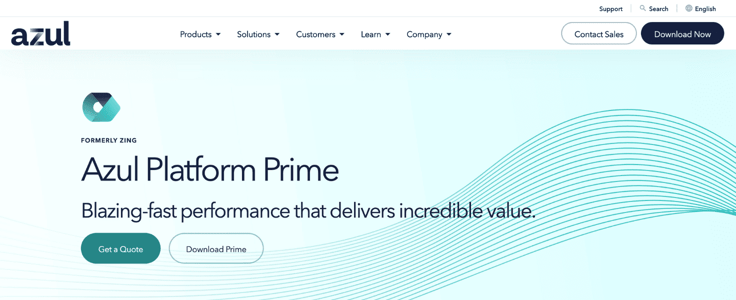
TL; DR: Azul offers a complete Java platform for modern-day cloud enterprises. Its suite of solutions allows users to optimize cloud costs, bolster app security, and increase performance on various fronts. Azul makes the perfect companion at a time when cloud costs continue to spiral, and low latency is of utmost importance. We spoke with Martin Van Ryswyk, CPO of Azul, about the platform, its solutions, and Azul’s history in the Java community.
Java was introduced to the programming world in 1995. Since then, Java has been a leading programming language. According to HostingAdvice, more than 30% of the world’s developers used Java in 2023. This stat only solidifies its reputation in the development industry — one that was partly built upon its “write once, run anywhere” principle.
Unlike with C and C++, developers don’t have to recompile Java to run compiled Java code on any platform. Java’s ease of use, open-source compatibility, high security, and rich feature set make it a relevant option in the modern era. That is evident in the fact that some of the globe’s biggest enterprises use Java, including Netflix, Priceline, and Mastercard.
Java allows companies to build highly secure and functional applications for various use cases, from big data tools to mobile banking apps. Enterprises in search of a Java platform to manage and track their Java projects can turn to Azul.

“We’ve expanded beyond being a JVM company. We’re trying to provide value to Java in general. We not only build JVMs and JDKs that customers use to run Java. We provide comprehensive support and expertise to our customers and are active in the Java community,” said Martin Van Ryswyk, CPO of Azul.
Azul is a complete platform for modern cloud-based Java development. Its primary solutions include Platform Core (a supported OpenJDK JVM), Platform Prime (a highly performant OpenJDK-based JVM), and Intelligence Cloud (a SaaS solution to bring users intelligence from their running JVMs), which serve as a reliable foundation for building stable, well-rounded Java applications. Below, we’ll dive further into Azul’s platform and its valuable features.
Azul Offers Better Cost Performance and Speed
Azul has served the Java community for more than 20 years. It has positioned itself as a leading Java platform for modern cloud enterprises and has delivered on that promise. About 36% of Fortune 100 companies trust Azul, which has seen hundreds of millions of downloads.
“The world’s biggest enterprise apps have been written in Java for a long time. There are reasons for that. There’s a lot to pull from open-source components. Many banks used Java early in the 90s, which has hardened and given it great cryptographic capabilities. If you’re doing something rock solid, you’re going to use Java,” said Martin.
With Azul Platform Core, customers have a drop-in replacement for Oracle Java SE, which some companies are reporting is now 2x – 12x more expensive since Oracle announced its new Java pricing policy in January 2023. The new pricing policy is based on an organization’s employee count, including part-time employees, contractors, and consultants, instead of based on usage.
While Java offers an excellent coding base, Azul provides the tools and resources to use it in the most efficient way. Its JVM and JDK solutions enable developers to create and run blazing-fast Java programs. Azul’s Platform Prime helps solve issues of consistency and speed for users.

“Consistency for their SLA and overall lower latency are really important. We have a solution for that. Our Platform Prime includes a JDK with all these performance enhancements to make it the Ferrari of OpenJDK,” said Martin.
Martin said users want higher performance for two reasons: speed and cloud cost optimization. According to the 2023 State of Java Survey & Report, 90% of respondents use Java in a cloud environment, and nearly 70% of companies say they are paying for unused cloud resources. Customers need solutions that can maximize cost performance.
“Customers have figured out that cloud costs are getting out of control. And if their machines could do more per machine, they would need fewer machines,” said Martin.
Azul’s Platform Prime offers a better Total Cost of Ownership. Azul has helped its customers reduce infrastructure spend by 38% and reclaim more than 20% in unused CPU, among other benefits.
Eliminate Vulnerabilities and Dead Code With Confidence
Azul’s Vulnerability Detection and Code Inventory modules, both part of the Azul Intelligence Cloud, a SaaS-based product that provides actionable intelligence from production Java runtime data, are game-changing Java solutions. These tools enable users to eliminate vulnerabilities, assess code, and do away with dead code with confidence. Dev teams no longer have to worry about breaking production to remove underutilized code.
This is how Azul came to develop its code detection tools. “We’re loading your app so we see everything. We run it, and then it’s gone. So we thought, why don’t we find ways to get some of that to our customers so that they can get value out of it,” said Martin.
Azul uses Java’s metadata to identify executed code and unused code and detect vulnerabilities in open-source components. Its vulnerability detection tool takes a different approach from other tools, providing users with precise details on the most urgent threats.
“All these other tools overload users with false positives when they never run code that has a known vulnerability. We give precise information to triage things they should and shouldn’t fix. Eventually, in the next quarterly release, they will fix everything. But if you don’t want to be hacked, fix this here now,” said Martin.
Azul AVD offers focused codebase forensics, including historical data to track threats across time and environments. Its code inventory feature, on the other hand, lasers in on the user’s own code. Martin said many customers let their codebases build over time, which results in old, unused code.
“Someone has to replace it, but they are afraid to take it out. So when they want to upgrade to a newer Java, they spend all these expensive developer resources updating lines of code that never runs,” said Martin.
Azul can see what code runs and what doesn’t and uses that information to help customers make code changes without fear. Its insights allow developers to remove code and avoid breaking production.
How Azul Contributes to the Java Community
Azul is an all-in-one resource for Java developers. It helps users with security, development, optimization, and so on. But it also contributes to the overall Java community. Two of its senior officers are members of the OpenJDK vulnerability group.
“We do a lot of work for OpenJDK and fixing bugs in Java that can be exploited. So that gives us the insight and experience to do security,” said Martin.
Since the team is an active contributor to Java, it can use its knowledge to improve Java in every way. The Azul team has also moved to SaaS products in recent years with the introduction of the Azul Intelligence Cloud.
“We’ve branched out from being a JVM company to also being a SaaS provider. So this is us moving into the SaaS world where we can offload analysis for customers. We can mature models faster because we’re running them and have access to it,” said Martin.


